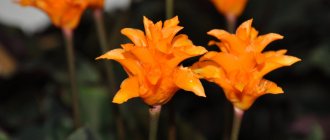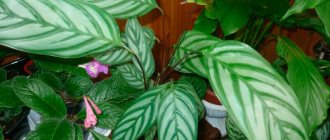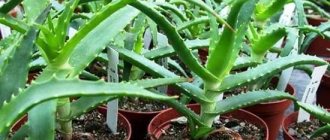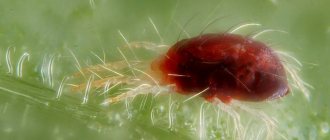Description of Calathea crocata
In the wild, this representative of the Marantaceae family grows in South America. We grow it as a houseplant. This variety of calathea is distinguished by beautiful variegated leaves, with seemingly striated lines.
She looks like an artificial flower. The leaf blades are large, oval in shape, 5-6 of them appear annually. This perennial plant is capable of flowering . It can grow up to a meter in height in an apartment, but more often its height does not exceed 40-50 cm.
Calathea rufibarba
The pointed-elongated leaves of this type of calathea, as in the photo, may seem ordinary in comparison with other types of this plant. The foliage has an even green color, which in some varieties extends to the back side. Yet calathea is very attractive due to the wavy shape of dense leaf blades sitting on long brownish-purple cuttings.
At home, the plant requires good nutrition and placement in diffused light. If the maintenance conditions are met, the gardener can get small yellow calathea flowers, as in the photo.
Home care
This flowering plant needs proper care. This is a rather capricious flower, which, if there are errors in its maintenance, will immediately lose its decorative appeal .
Important! Caring for such a specimen involves not only watering and fertilizing, but also proper adjustment of daylight hours.
Lighting
The plant needs long daylight hours (8-10 hours). It is better to choose a bright place for the flower, but bright and direct sunlight may cause burns on the foliage .
Therefore, it is preferable to grow the flower on eastern or western windowsills.
Watering
Calathea saffron is demanding on the humidity of the surrounding space. If this parameter is low, not only will it not bloom, but its leaves will dry out, curl, and fall off .
Every other day you will have to spray the plant, wipe its foliage with a wet sponge, and place the pot on a tray filled with wet pebbles.
Note! In summer, the plant is watered once every 2-3 days; in winter, once a week is enough. It is important to ensure that there is no overflow. Water for irrigation should be at room temperature or slightly warmer.
Top dressing
In the warm season (from mid-spring to autumn), the flower must be fertilized every two weeks; in cold weather, fertilizing is applied once a month . For saffron calathea, you can purchase any universal fertilizers aimed at flowering species.
Temperature
For a heat-loving plant, the optimal conditions are +18...+25 degrees. However, it cannot be placed on a window that is opened for ventilation, since the culture does not tolerate drafts .
In winter, calathea can exist at low temperatures (8-10 degrees), but it needs to be watered less often.
How to make calathea bloom?
Calathea crocata, if provided with ideal conditions, blooms in the middle of winter with unusually shaped, fragrant flowers of orange or yellowish color .
For a plant to bloom, it needs a preparatory period. In mid-autumn, the flower's daylight hours are reduced to 10 hours .
To do this, after 18.00 and until the morning, the specimen is covered with a black (dark) bag, always large, so that the polyethylene does not come into contact with the foliage. Keep the indoor plant this way until mid-winter , until it begins to bud.
Zebrina, Crocata, Medallion and other common species
Saffron Calathea, or Calathea crocata. This species is distinguished not only by its decorative foliage, but also by its beautiful bright orange flowers. The leaves are dark green with light stripes and burgundy on the inside. Flowering occurs in mid-winter and lasts about two months.
Calathea saffron is less whimsical than its other brothers, so it’s worth starting to get acquainted with this family with it.
Calathea lancifolia, or wonderful (Calathea lancifolia) . The species has long lanceolate leaves with a slightly wavy edge and low petioles. The color is usually light green with short dark veins.
Calathea orbifolia, or round-leaved (Calathea orbifolia) . The name speaks for itself - this species has an almost round leaf blade located on a petiole 40–60 cm high. The leaf is painted with alternating stripes of green and white.
Calathea makoyana . One of the most popular types. The leaves are large, up to 30 cm in size, light green, with an unusual pattern of dark green stripes and red veins. The lower part of the leaf is pale pink.
calathea , or ornata (Calathea Ornata) . The plant is about 50 cm tall with large brown-green leaves, on which white and pink veins are clearly visible.
Pink Calathea, or Medallion (Calathea roseopicta) . Compact low bush with rounded leaves. The color is zonal, combining light green, milky and pinkish colors.
Calathea rufibarba . Lanceolate appearance. The color is rich green, the petiole and lower part of the leaf are covered with rusty-red fluff, for which the plant got its name, which translates as “red beard.”
Calathea zebrina, or striped Calathea zebrina . The plant is about 40–60 cm high with large oval leaves. The color is bright green with light and brownish stripes. The lower part of the leaf is burgundy.
Calathea zebrina is capable of flowering indoors, although this happens very rarely.
Calathea warscewiczii . The leaves are dark green in color with lighter stripes. The underside of the leaf plate is red-burgundy in color. The plant sometimes produces cone-shaped inflorescences with cream, white or pinkish flowers.
Photo gallery: popular varieties of calathea
Calathea zebrina
Kalathea Varshevich
Calathea rufibarba
Calathea Medallion
Calathea sanderiana
Calathea orbifolia
Calathea Makoya
Calathea lancifolia
Calathea saffron
Calathea Litze
Calathea Veitcha
Calathea Lubbersa
Calathea leopardis
Calathea network
Calathea mix
Reproduction of calathea at home
First of all, you need to take care of suitable soil. It is prepared according to the following calculation: for every 2 volumes of leaf soil, take 1 volume of river sand and peat , and also add a little crushed bark or coal.
The soil should be light and breathable. Drainage is provided at the bottom of the pots .
The flower is propagated in several ways:
- Dividing the bush. This is the simplest option. During spring replanting, an adult plant is divided into several parts so that each piece has several formed leaves. Each division is planted in a separate pot . At first, the separated parts can be kept in a greenhouse for better rooting.
- Leaf and cuttings. This is a more complex method. Necessary take a leaf from an adult plant or a cutting and plant it in moist soil, keep it in a greenhouse until rooting.
- Growing from seeds. The most complex method, suitable for the most experienced gardeners. It is better to grow the plant from purchased seeds. They are first treated with a weak solution of potassium permanganate (1 g per 100 ml of water), then sown in a mixture of earth and sand in a ratio of 2:1 . Keep under film until the first leaves appear.
Young calathea seedlings are even more capricious than an adult plant . They are very sensitive to temperature changes.
This video explains how to transplant and propagate calathea from cuttings.
Calathea bachemiana
The leaves of this type of calathea are quite narrow and long, up to 35 cm. They are held on thin elongated cuttings and form a dense rosette above the ground surface. A characteristic feature of the species is the silvery color of the upper part of the leaf blade, on which a dark green ornament in the form of an elegant branch stands out clearly.
The flowers of Calathea Bachema are not as decorative as those of Calathea saffron, but they greatly enliven the overall picture and are of interest to lovers of tropical crops.
Benefits and harms
The plant creates a healthy atmosphere indoors. Calathea leaves clean the air from dust, smoke and other microparticles, increasing the oxygen content .
Gardeners choose this plant for its properties:
- this is the only flowering representative among the Kalathas;
- beautiful flowers and leaves make the plant very attractive ; it is used to decorate various rooms;
- flowers appear in winter, they are orange, reminiscent of summer;
- buds bloom for a long time (1.5-2 months).
But, like any plant, Calathea crocata has a number of disadvantages. The aroma of blooming flowers is quite specific; not everyone likes it .
The plant is capricious, especially demanding of air humidity. In order for Calathea to feel good and regularly delight with abundant flowering, it needs to regulate daylight hours .
Attention. Calathea crocata should not be grown by those who are just starting out in floriculture. It is more suitable for experienced florists.
How to replant a flower, including after purchase
After purchase, the plant must be replanted. Calathea roots release toxic substances into the ground, so replacing the pot and soil is necessary. In the future, the bush requires replanting into a larger diameter pot every 1–2 years. The best time for this is February or March.
For calathea, you should choose a wide, shallow pot, since the entire root system of the plant is located just below the surface of the soil. At the bottom it is necessary to make a good drainage layer of pebbles or expanded clay to prevent stagnation of water.
The calathea pot should be low
You can buy ready-made soil (for arrowroot) or prepare it yourself according to the following proportions:
- leaf soil - 2 parts;
- humus or compost - 2 parts;
- peat - 2 parts;
- coarse sand - 1 part.
Calathea does not tolerate calcareous soil, so the composition and quality of both purchased and homemade soil must be carefully monitored.
Calathea has a very delicate root system and can be easily damaged. Therefore, take it out for replanting with little effort, gradually, together with the earthen lump, turning the pot on its side.
When planting, it is unacceptable to press the soil tightly around the roots.
Video: planting and replanting calathea
Diseases and pests
Calathea crocata is often affected by spider mites. It is not so easy to notice, so the plant must be carefully inspected regularly. For preventative purposes, wash it periodically with soap . In case of infection, treat with insecticides. Another pest that affects Calathea is scale insects and thrips. To combat them, Confidor and Fitoverm will be useful.
Also, one of the most common problems that gardeners face when growing this plant is the leaves drying out or darkening (described in detail here). This happens from improper watering and low humidity . This also happens if water that is too hard and contains a lot of calcium is used.
Note! When discolored spots appear on the leaves, the plates dry out and curl - these are signs of sunburn. The plant must be moved to a dark place. This crop can curl its leaves even at low temperatures, as well as due to drafts.
Although Calathea crocata is a capricious plant, it fully compensates for this deficiency with beautiful, abundant flowering and decorative leaves . And any skills are acquired with experience. Place such a beauty on your windowsill, and it will definitely delight you with its appearance.
This video talks about calathea and shows how you can try to save a diseased plant.
Disease Prevention
The loss of decorativeness and death of calathea can be caused not only by improper care, but also by damage to various diseases or pests. The main problem when growing in home floriculture is often yellowing and wilting of the leaves. In order to promptly detect the affected parts of the crop and take the necessary treatment measures, you need to conduct regular inspections of indoor plants. Diseases caused by improper care include:
- drying of the tips of the foliage and slower growth due to insufficient watering or too low air humidity in the house;
- foliage falls and curls most often due to cultivation in rooms with too dry air;
- rotting of the stem and foliage can be caused by low temperature conditions;
- the foliage acquires an uncharacteristic pale coloration when exposed to excessive sunlight.
Indoor saffron calathea is relatively rarely affected by plant parasites, including spider mites, scale insects, whiteflies and mealybugs. If, when affected by non-infectious diseases, it is enough to provide the plant with proper care, then to combat pests and pathogenic microflora it will be necessary to use strong means.
The indoor plant should be treated with Actofit , diluted at the rate of 4 ml per liter of water. After a couple of weeks, you need to spray the above-ground part with Confidor, diluted at the rate of a quarter of a packet per liter of water at room temperature.











